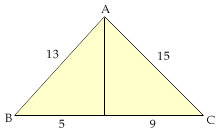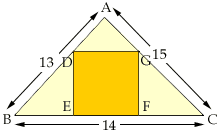All the submitted solutions made use of the same two basic steps, but each had its own insight. To display the different approaches to the problem, for our featured solution we have combined the work of
Jeff Eggen (Regina)
Normand Laliberté (Ontario)
Leti Gimeno (Spain)
Juan Mir Pieras (Spain)
Alexander Potapenko (Russia)
Step 1. Determine the altitude from A to BC.
Approach (a).

 .
.
Since the base BC = 14, the corresponding height must be (Area)/7 = 12.
thus, BH = 5, so that AH = 12. Note that this approach also provides the mathematics behind the observation in (a).
Step 2. Determine the side of the square using the fact that Triangle ADG ~ triangle ABC.

Let x be the side of the inscribed square: x = DE =EF = FG = DG.
Approach (a). (Eggen, Potapenko and Laliberté)
and
Since these ratios are equal we have 12-x/x = 12/14. Solving for x we find that the unknown side length is x = 84/13. Actually, Eggen and Laliberté used trigonometry, which leads to a similar computation.
= Area(ADG) + [Area(BED) + Area(GFC)] + Area(DEFG)
= (1/2)x(12 - x) + (1/2)x(14 - x) + x2
= 13x
The side of the square is therefore x = 84/13.

Consider the infinite sequence of similar triangles with their inscribed squares. The original triangle ABC and its square DEFG is shrunk by a factor of k to a similar triangle ADG with its square, and so on. If the length of a side of the first square is x, then the square in ADG has side length kx, and that square determines the next triangle with its square of length k2x, and so on. Since the squares fill in the entire height we have.
= x + kx + k2x + ...
= x(1 + k + k2 + ...)
= x/1 - k
To find k, note that the side of the first square comes from shrinking the base of the original triangle: x = 14k, so that k = x/14. The problem has been reduced to solving
for x. Once again we compute that x = 84/13.